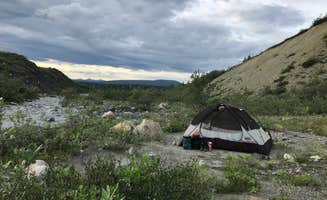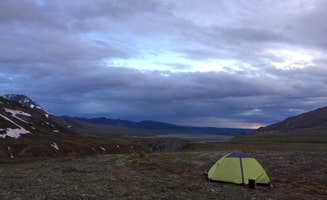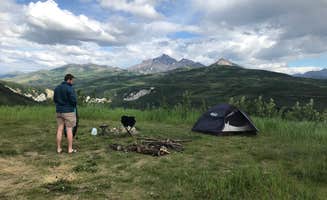Tent camping near Denali National Park & Preserve offers primitive wilderness experiences at elevations ranging from 1,700 to 3,900 feet. The park's camping season typically runs from late May through mid-September, with peak visitation in July when temperatures average 50-70°F. Wilderness units require backcountry permits obtained from the Backcountry Information Center, which opens daily at 9 AM during summer months.
What to do
Wildlife viewing from campgrounds: Igloo Creek Campground provides excellent opportunities to spot Denali wildlife from your tent site. Located 35 miles into the park, its riverside location attracts various animals. One camper notes, "Attractions include creek, Denali park, hiking, wildlife" while emphasizing the "private, wooded" nature of the walk-in sites.
Day hiking near Wonder Lake: Several established trails start near Wonder Lake Campground, including the McKinley Bar Trail. According to one camper, "There is a short path behind the common area that leads to Wonder Lake. The lake is also a great spot to view wildlife and if you are into fishing I recommend bringing a fishing pole. The fish in the lake are very active and will bite on anything."
Photograph alpenglow: Capture the unique light conditions when camping at the end of the park road. A Wonder Lake visitor reports, "Watch the alpenglow and possibly the northern lights," highlighting photography opportunities during extended summer daylight hours when the sun barely sets.
What campers like
Tent site privacy: Campers appreciate the separation between sites at most Denali campgrounds. At Sanctuary River Campground, "There aren't many sites in this place, maybe 10 or so but they are spread out and nice. Only tent sites with no hook ups."
Bear-safe food storage: Substantial storage lockers at Wonder Lake allow for more elaborate meals than typical backcountry camping. One camper advises, "The bear locker is huge! Bring as much as you are willing to lug out there! We were having Turkey patty melts with all the fixings while others were just eating pb&js. Don't limit yourself!"
Alpine tundra access: Backcountry Unit 13: Mount Eielson provides direct access to tundra landscapes. A backpacker describes, "On just the other side of the Eielson visitor center you will find vast tundra, rivers, glacial lakes, and glaciers. I saw a herd of 30 caribou here just grazing and getting in the way of my path."
What you should know
Mosquito preparation essential: Insects can be extremely dense, particularly at certain campgrounds. An Igloo Creek camper warns, "We were told mosquitoes were the national bird of Alaska haha. It is no joke at this campground. Be prepared for me."
Transportation logistics: Getting to campgrounds requires advance planning. For Sanctuary River Campground, "We took the shuttle bus in, since that's the only way to get there, stayed for a night and then moved on."
Water availability varies: Potable water is unavailable at many sites. At Sanctuary River, "Be prepared because there is no drinking water here so you need to bring your own or some way to purify it."
Limited visibility of Denali: Cloud cover frequently obscures mountain views. A Wonder Lake camper shares, "Our first two days in the park were completely cloudy and rainy with no visibility of Denali. We were losing hope that we would ever see the mountain until we woke up on our third morning."
Tips for camping with families
Short trails for children: Some accessible trails work well for families with young hikers. A camper suggests, "I would definitely recommend checking out horseshoe lake trail if you need an easy hike and want some nice views. I think it was about 2 miles without much elevation gain."
Pack extra warm layers: Even summer temperatures can drop unexpectedly. Nighttime temperatures can fall below freezing even in July. Weather patterns change rapidly due to mountain terrain, requiring appropriate clothing for all conditions.
Multiple days increase mountain viewing chances: Wonder Lake Campground offers the iconic Denali views when weather permits. A camper recommends, "I would recommend reserving a few days to give yourself a better chance of seeing the great views the campground has to offer."
Tips from RVers
No RV access to deep park campgrounds: RVs can only access the first 15 miles of park road. Beyond this point, tent camping is the only option, and all gear must be transported via park shuttle bus.
Primitive RV camping: Backcountry Unit 18: Muldrow Glacier areas require complete self-sufficiency. A visitor cautions, "Getting to the camp spots on the other hand is more difficult! You have to cross so many rivers just to get to the start of the glacier area. Expect to be hiking 3-4 hours just to get to the front of the inlet area."
Store adequate provisions: Pack sufficient supplies as there are no services past the park entrance area. The nearest resupply options are in Healy, approximately 11 miles north of the park entrance.





